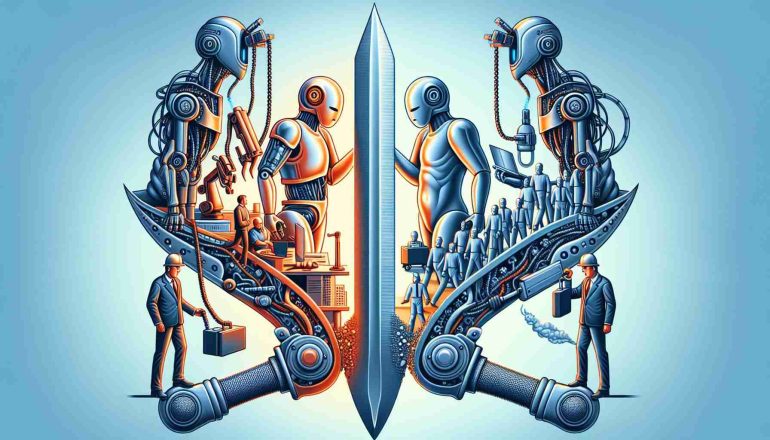- AI is advancing rapidly, raising concerns about potential widespread unemployment.
- Jobs involving repetitive tasks are most at risk, while creative and problem-solving roles are less vulnerable.
- AI creates new employment opportunities in areas like AI development, data analysis, and cybersecurity.
- Upskilling and reskilling are critical for workers to adapt to the evolving job market.
- The unequal impact of job displacement could widen socioeconomic divides.
- Businesses benefit from AI through increased productivity, cost savings, and improved decision-making.
- Ethical concerns include job displacement and biases within AI systems.
Main AI News:
The rapid advancement of artificial intelligence (AI) has sparked growing concerns about its impact on human jobs. As AI becomes more capable of automating tasks across manufacturing and customer service sectors, many individuals fear widespread unemployment. While AI promises to boost productivity and generate new job opportunities, many people are worried about the future of their careers.
Recent research from leading institutions suggests that many jobs are at high risk of automation in the coming years. Experts indicate that completely replacing human workers with AI in industrial settings may not happen immediately, but it is a genuine concern. Developing sophisticated AI systems presents substantial challenges in cost and complexity, and the maintenance and training required for these systems are considerable. Some experts predict that full automation could still take years, if not decades, to become a reality.
Despite these obstacles, more than 61% of large corporations in the United States are actively pursuing AI solutions to replace human labor. This growing trend raises important questions about the future of work. Although AI offers clear benefits regarding increased efficiency, it also introduces new challenges. The ongoing debate focuses on which types of jobs are most vulnerable as AI technology reshapes the workforce.
Roles that involve repetitive tasks or routine cognitive functions are particularly susceptible to automation. Positions like data entry, telemarketing, and specific manufacturing jobs are seen as the most at risk. In contrast, jobs that require complex problem-solving, creativity, or human interaction, such as healthcare and creative professions, are less vulnerable. However, AI is also creating new employment opportunities in areas such as AI development, data analysis, cybersecurity, and the ethical governance of AI systems. These new fields require workers to possess the skills to manage, maintain, and improve AI technologies.
As AI transforms the labor market, upskilling and reskilling become essential. Workers must be trained in digital literacy, machine learning, and AI-related skills to adapt to new roles that are less likely to be automated. Such training programs can empower employees to transition into positions that demand more advanced capabilities, helping them remain relevant in the evolving job landscape.
The integration of AI into the workforce has its challenges. One of the major concerns is the unequal impact on workers, as lower-skilled employees are more likely to experience job loss. At the same time, those with advanced education or specialized skills may find new opportunities. This disparity risks widening existing socioeconomic divides. Additionally, ethical questions arise about the responsibility of corporations and governments in managing the transition. Policies such as a universal basic income or significant investments in education and job training may be crucial in helping displaced workers navigate the changing economy.
On the positive side, AI offers several advantages to businesses. It can perform repetitive tasks more quickly and accurately than humans, increasing productivity and profitability. Moreover, AI can analyze large volumes of data, providing insights that help businesses make better and faster decisions. Automating tasks can also reduce costs, allowing companies to reinvest in growth areas and innovation.
However, these benefits are accompanied by significant drawbacks. The most pressing concern remains the displacement of jobs, particularly for low-skilled workers who may struggle to transition into new roles. The growing demand for tech-savvy workers also highlights the need for comprehensive training programs to close skill gaps. Furthermore, AI systems can unintentionally reinforce biases in their training data, leading to unfair hiring practices and employment decisions.
Conclusion:
The continued integration of AI into the workforce brings opportunities and challenges to the market. Companies will see gains in efficiency, cost reduction, and decision-making abilities, positioning AI as a critical driver of competitive advantage. However, sectors with lower-skilled jobs face substantial disruption, which could deepen economic inequalities. For the market, this means a shift toward a higher demand for specialized skills and a corresponding increase in the need for investments in workforce training. Companies and governments must collaborate on strategies to manage the transition, ensuring that the benefits of AI are shared and that the labor market remains resilient amidst these changes. The businesses that can effectively navigate these dynamics will likely lead to the next technological and economic development phase.

